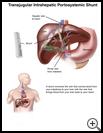
Transjugular Intrahepatic Portosystemic Shunt
________________________________________________________________________
KEY POINTS
- Transjugular intrahepatic portosystemic shunt (TIPS) is done to improve blood flow to and from the liver. TIPS places a small tube between the veins that carry blood from your intestines to your liver, and from your liver to your heart.
- TIPS helps reduce blood pressure in your veins and prevent fluid buildup in your chest and belly.
- Ask your provider how long it will take to recover and how to take care of yourself at home.
- Make sure you know what symptoms or problems you should watch for and what to do if you have them.
________________________________________________________________________
What is a transjugular intrahepatic portosystemic shunt?
Transjugular intrahepatic portosystemic shunt (TIPS) is a procedure done to improve blood flow to and from the liver. With TIPS, a needle is inserted through a vein in your neck to place a small tube between your portal vein and one of your hepatic veins. The portal vein carries blood from your intestines to your liver. The hepatic veins bring blood from your liver back to your heart.
When is it used?
Normally, blood coming from your esophagus, stomach, and intestines flows through the liver. Liver disease and scarring can block blood flow and increase pressure in the portal vein. This is called portal hypertension. Portal hypertension may be caused by:
- Alcohol abuse
- Too much iron in the liver
- Liver infections such as hepatitis B or hepatitis C
High blood pressure in the portal vein causes blood to move backward. This backwards flow of blood makes the veins swell, and fluid collects in your chest and belly. The increased pressure can cause bleeding of swollen veins in your esophagus.
The shunt reduces pressure in your veins and helps blood to flow from your intestines, through your liver, and back to your heart. This helps the veins shrink back to normal size and can help stop or prevent fluid buildup in your chest and belly.
How do I prepare for this procedure?
- Plan for your care and find someone to give you a ride home after the procedure.
- Your healthcare provider will tell you when to stop eating and drinking before the procedure. This helps to keep you from vomiting during the procedure.
- You may or may not need to take your regular medicines the day of the procedure. Tell your healthcare provider about all medicines and supplements that you take. Some products may increase your risk of side effects. Ask your healthcare provider if you need to avoid taking any medicine or supplements before the procedure.
- Tell your healthcare provider if you have any food, medicine, or other allergies such as latex.
- Follow your healthcare provider's instructions about not smoking before and after the procedure. Smokers may have more breathing problems during the procedure and heal more slowly. It is best to quit 6 to 8 weeks before surgery.
- Follow any other instructions your healthcare provider gives you.
- Ask any questions you have before the procedure. You should understand what your healthcare provider is going to do. You have the right to make decisions about your healthcare and to give permission for tests or procedures.
What happens during this procedure?
You will be given local or general anesthesia to keep you from feeling pain during the procedure. Local anesthesia numbs the area where the needle will be inserted in your neck. You may also be given a sedative to help you relax but you may be awake during the procedure. General anesthesia relaxes your muscles and puts you into a deep sleep.
A radiologist will put a flexible tube called a catheter into a vein in your neck, through a needle. Using contrast dye and special X-rays, your provider will guide the catheter into a vein in your liver. He will connect the portal vein to one of your hepatic veins, using a stent to keep the connection open.
The procedure takes 1 to 3 hours.
What happens after this procedure?
You will stay in the hospital for at least 1 to 2 days. Follow your healthcare provider’s advice about diet when you go home.
Ask your healthcare provider:
- How and when you will get your test results
- How long it will take to recover
- If there are activities you should avoid and when you can return to your normal activities
- How to take care of yourself at home
- What symptoms or problems you should watch for and what to do if you have them
Make sure you know when you should come back for a checkup. Keep all appointments for provider visits or tests.
What are the risks of this procedure?
Every procedure or treatment has risks. Some possible risks of this procedure include:
- You may have problems with anesthesia.
- You may have infection, bleeding, or blood clots.
- You may have an allergic reaction to the dye.
- There is a risk of bleeding and damage to blood vessels.
- The shunt may narrow or get blocked, and you may need another procedure.
- Encephalopathy, which often happens with severe liver disease, may get worse. This condition may cause memory problems, confusion, seizures, and coma.
Ask your healthcare provider how these risks apply to you. Be sure to discuss any other questions or concerns that you may have.

